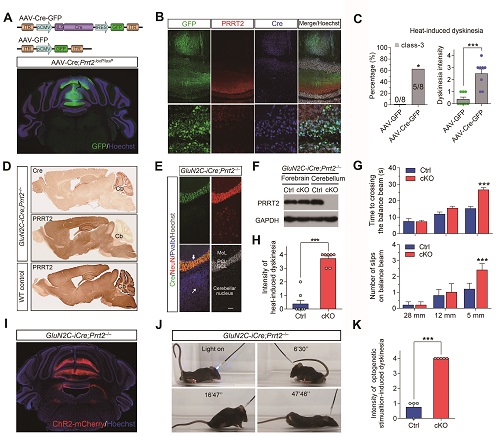Paroxysmal kinesigenic dyskinesia (PKD) is the most common hereditary paroxysmal movement disorders, characterized by attacks of choreic and/or dystonic movements, that are triggered by sudden voluntary movement. The genetic basis was discovered in 2011 when mutations in the gene PRRT2 were identified in Chinese families with PKD. Since then, there are over 100 reports on PRRT2 in PKD patients from different ethnic backgrounds, and in other paroxysmal disorders such as benign familial infantile convulsions (BFIC), infantile convulsions with choreoathetosis (ICCA). However, the biological function of PRRT2 and its pathologic mechanism underlying PKD remain largely obscure.
A recent study carried out by Dr.Tan et al from Dr. XIONG Zhiqi’s laboratory, at the Institute of Neuroscience, Chinese Academy of Sciences, showed that PRRT2 is a presynaptic protein that interacts with components of SNARE complex and down-regulates its formation.
Loss-of-function mutant mice showed PKD-like phenotypes triggered by generalized seizures, by hyperthermia, or by optogenetic stimulation of cerebellum. Mutant mice with specific PRRT2 deletion in cerebellar granule cells, recapitulates the behavioral phenotypes in Prrt2-null mice, indicating that cerebellum is a key area mediating PRRT2 function in controlling movement. Furthermore, recording results in cerebellar slices showed that optogenetic stimulation of granule cells (GCs) resulted in transient elevation followed by suppression of Purkinje cell (PC) firing. The anticonvulsant drug carbamazepine (CBZ) used in PKD treatment also relieved PKD-like behaviors in mutant mice. Together, their findings identified PRRT2 as a novel regulator of SNARE complex and provided a circuit mechanism underlying the PRRT2-related behaviors.
This work entitled“PRRT2 deficiency induces paroxysmal kinesigenic dyskinesia by regulating synaptic transmission in cerebellum” was published online On Oct20, 2017 in Cell Research as an research article. This work was carried out by Drs.TAN Guohe,LIU Yuanyuan, WANG Lu, and LIKui et al. This work was supported by grants from Ministry of Science and Technology of China,National Natural Science Foundation of China, Chinese Academy of Sciences,and Science and Technology Commission of Shanghai Municipality, etc.

Figure1. Cerebellum is a key area mediating PRRT2-related dyskinesia. (A-C) Heat induced paroxysmal dyskinesiain AAV-Cre;Prrt2–/–withPRRT2 protein in infected cerebellar neuron.(D-H) Induced paroxysmal dyskinesiaof GluN2C-iCre;Prrt2–/–mice in which PRRT2 was ablated selectively in cerebellar granule cells.(I-K) Optogenetic stimulation-induced dyskinesia in a GluN2C-iCre;Prrt2–/– mice.

Figure2. This image (conceived by Guohe Tan; drawn by Shuyang Zhou of the Apex Science Media inc. in Shanghai, China) depicts the traditional spring festival in traditional Chinese brush painting. The big tree is apparently like a Purkinje cell receiving inputs from the cerebellar granular cells (Chinese lanterns) where PRRT2 deficiency causes changes in synaptic transmission between them within the cerebellum (like the mountain). The image further emphasizes that subsequent abnormal PC firing (firecracker) triggers paroxysmal kinesigenic choreoathetosis which onset typically occurs during childhood or adolescence.

